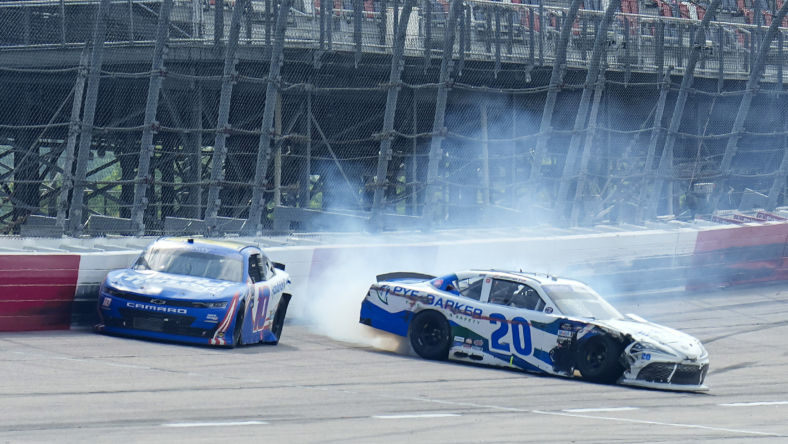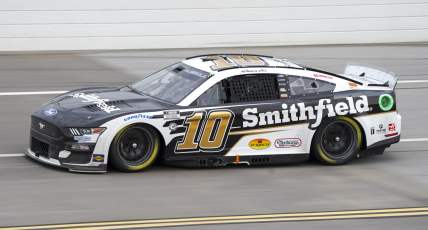NASCAR has mandated a series of safety updates to the Cup Series car following an extensive investigation and recreation of the April 23 incident at Talladega Superspeedway involving Ryan Preece and Kyle Larson.
During the incident, Larson initiated a bump draft on Ross Chastain, resulting in contact with Noah Gragson. The resulting contact sent Gragson head-on into the outside retaining wall. Larson spun toward the apron but came right back up the surface and was t-boned by Preece.
The impact was so massive that it bent the right-side door panel on the Hendrick Motorsports No. 5 car. Both drivers were released from the infield care center afterwards but cited it amongst their hardest impacts ever.
Related: Upcoming NASCAR schedule
In the months since, NASCAR had taken both cars to its research and development center in Concord, North Carolina to recreate the crash digitally and first understand what happened. It found that the crash featured a difference of speed of 59 mph at a 55-degree impact angle.
What all of this means, at least to the average fan, is a fair question. Replacement in the name of safety, NASCAR had already begun working towards a front clip update as well, but the Talladega crash provided both increased understandings of where improvements can be made and a sense of urgency to make them.
The changes were crash tested at the Transportation Research Center in East Liberty, Ohio, a specialized facility used for all manner of simulation across a variety of transportation industries. After a testing a variety of changes, NASCAR ordered the following rules updates to the chassis in advance of the July 9 race at Atlanta Motor Speedway
New NASCAR rules following Talladega crash

FRONT CLIP
- Removal of front clip components to allow for a softer and larger crush zone for frontal impacts
- An empty front ballast (weight) box and modified cross brace to soften the crush zone
- Notches, 44 triggers in total, in the rails to decrease front rigidity
FRONT BUMPER STRUT
- The addition of four main slots, or holes, in the right and upper strut
- Two additional notches, or triggers, on the longitudinal leg
- Eight main slots in the right and left lower struts
CENTER SECTION
- Replacing a bolt-on aluminum door bar with a 0.060” welded steel equivalent
- Two left side door plate gussets
Essentially, NASCAR determined that the front clip was too rigid, in the same way it determined the same about the rear clip over the winter following an investigation into the crash and concussion that seemingly ended the career of Kurt Busch.
Because the front clip is so rigid, the impact from the Ryan Preece car to the Kyle Larson right side door panel, was increasingly intrusive. The changes make the front clip softer in the sense that it caves-in more easily but not so much that it compromises the firewall and overall driver compartment.
That’s the balancing act when it comes to such changes.
As for the right-side door panel, the swap to a welded-on steel plate from a bolted-on aluminum one increases its impact durability. All told, this adds about five pounds of weight to the car. The increase in right side weight was mostly offset by the decrease in front weight.
But the main takeaway here is that NASCAR has strengthened door panel impact by softening the front impact — the latter potentially having positive safety implications for a variety of head-on impacts for the remainder of the season.
These changes were detailed on Thursday in a media briefing by Dr. John Patalak, vice president of safety engineering at NASCAR.
“By removing that material, from an engineering standpoint, we’re reducing the buckling strength of those individual parts and pieces,” said Patalak. “Overall, the simplified version is that we’re increasing the amount of crush that the front clip will be capable of. That’s all an effort to reduce the accelerations in the center-section that the driver will be exposed to in these kind of crashes.”
In the interest of expediency, NASCAR is allowing teams to install these changes themselves or send the chassis back to spec manufacturer Technique to have them installed instead. NASCAR’s Vice President of Vehicle Design, Brandon Thomas, does not believe this will present a risk to its competition and parity goals with the single source supplied platform.
“In order to get everyone an opportunity to stay on the build schedule, allowing teams that previously built these pieces or still have the fabricators on staff, this was an efficiency move,” Thomas said. “I don’t see this as a Pandora’s Box right now.
“I see that everyone has a vested interest in making this work or making this work to the best we can. We are relying on the teams to carry out their end of that bargain.”
When NASCAR implemented the rear clip changes in the off-season, it incurred the cost instead of making the teams pay for it, and Thomas indicated that will be the case here as well.
“We will work on an arrangement with the teams,” Thomas said. “It’s not finalized but we will participate in the cost here as well.”
Matt Weaver is a Motorsports Insider for Sportsnaut. Follow him on Twitter.
